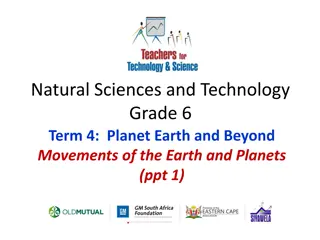Understanding Earth's Seasons and Moon Phases
Explore the primary causes of Earth's seasons, the positioning of winter in the Northern Hemisphere, and the eight phases of the lunar cycle. Learn about the characteristics of the moon in its waxing and waning phases, the time it takes to transition between moon phases, and the role of the sun in the lunar cycle.
Download Presentation

Please find below an Image/Link to download the presentation.
The content on the website is provided AS IS for your information and personal use only. It may not be sold, licensed, or shared on other websites without obtaining consent from the author. Download presentation by click this link. If you encounter any issues during the download, it is possible that the publisher has removed the file from their server.
E N D
Presentation Transcript
QUESTION 1 Which of these is the primary cause of the Earth s seasons? A. Earth s gravitational attraction to the sun B. The distance between Earth and moon C. The tilt of the Earth s axis as it revolves around the sun D. The moon s revolution around the Earth
QUESTION 2 Label your seasons for numbers 1-4
QUESTION 3 At what position does winter take place in the Northern Hemisphere? A. 1 B. 2 C. 3 D. 4 4 1 3 2
QUESTION 4 At what positions does the earth get equal amount of daylight hours on both hemispheres? A. 1 and 3 B. 2 and 4 C. 1 and 2 D. 3 and 4 4 1 3 2
QUESTION 5 Which one is an example of ROTATION and REVOLUTION (ORBIT) How do you know? Explain.
QUESTION 5 Name the eight phases of the lunar cycle in order.
QUESTION 6 ANSWER IN COMPLETE SENTENCES BY COMPLETING THE italic SENTENCE STEM 1. What are the characteristics of the moon in its waxing phase? When the moon is _______________________. 2. What are the characteristics of the moon in its waning phase? Waning means that _______________________.
QUESTION 7 1. HOW LONG DOES IT TAKE TO GET FROM ONE MOON PHASE TO ANOTHER? 2. HOW LONG DOES IT TAKE TO GET THROUGH THE ENTIRE CYCLE? 3. WHAT IS THE ROLE OF THE SUN IN THE LUNAR CYCLE? THE SUN S ROLE IS ______________________________________________
TIDES STATIONS REVIEW QUESTIONS
QUESTION 1 What causes tides? a. Gravity of moon b. Gravity of sun c. Rotation of earth on its axis d. All of the above
QUESTION 2 How many high tides would any particular area experience every twenty-four hours? a. one b. two c. three d. four
QUESTION 3 Which statement best describes tides experienced on Earth when the Sun, Moon, and Earth are positioned as shown in the diagram? a. maximum high tides, minimum low tides b. maximum high tides, maximum low tides c. minimum high tides, maximum low tides d. minimum high tides, minimum low tides
QUESTION 4 Neap tides are caused by a. the alignment of the moon and the sun 180 degrees. b. the alignment of the moon and sun 90 degrees. c. the alignment of the moon and sun at opposite ends of the Earth. d. the sun's position does not matter because it is too far away.
QUESTION 5 Spring tides are caused by a. the alignment of the moon and the sun 180 degrees. b. the alignment of the moon and sun 90 degrees. c. the alignment of the moon and sun at opposite ends of the Earth. d. the sun's position does not matter because it is too far away.
QUESTION 6 If the Sun, Earth, and Moon are lined up as follows, the Earth would have__________. A. B. C. D. Spring Tides, which is when there are very high tides and very low tides. Spring Tides, which is when there are almost no tides. Neap Tides, which is when there are very high tides and very low tides. Neap Tides, which is when there are almost no tides.
QUESTION 7 If the Sun, Earth, and Moon are lined up as follows, the Earth would have__________. A. Spring Tides, which is when there are very high tides and very low tides. B. Spring Tides, which is when there are almost no tides. C. Neap Tides, which is when there are very high tides and very low tides. D. Neap Tides, which is when there are almost no tides.
QUESTION 8 Which points in the diagram of the earth would have High Tides? A. 1 and 4 B. 2 and 3 C. 1 and 3 D. 4 and 3
QUESTION 9 Which of the following diagrams represent the highest tides? (The largest ball represents the sun, the middle size ball represents Earth, and the small ball represents the moon.) A. B. .C. D. NOT A SUFFICIENT ANSWER























